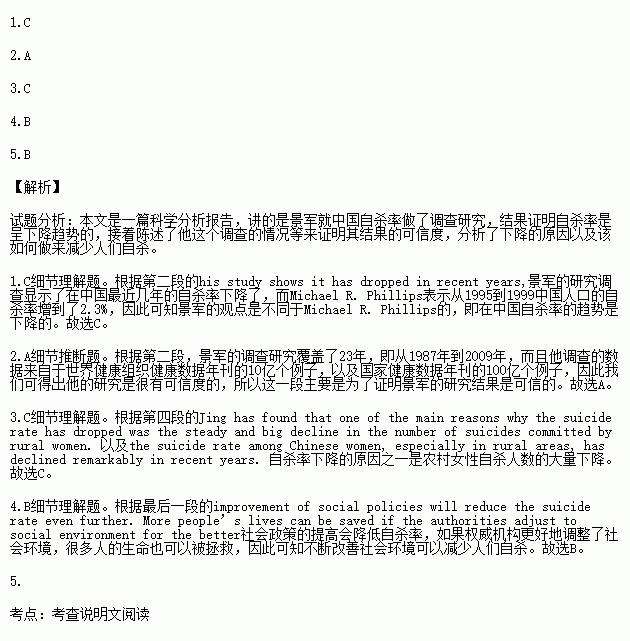题目内容
Ever since Canadian psychiatrist Michael R. Phillips, who works in China, released his report saying China’s suicide rate from 1995 to 1999 reached 0.023 percent, the country has been ranked among those with the highest suicide rates in the world. But Jing Jun, a professor of sociology in Tsinghua University, challenges that view and presents the true picture through his nationwide research.
Jing and his students took one year to set up the first national database on suicide rate to grasp the overall trend of suicides in China. They collected data from the Health Statistics Annuals of the World Health Organization (sample size 10 million), and the country’s Health Statistics Annuals (which cover 100 million people). The database covers 23 years, from 1987 to 2009. Jing calculates the suicide rate in China based on these data. Though the suicide rate was comparatively high in the early years, his study shows it has dropped in recent years, as opposed to the ascending trend in the rest of the world.
According to Jing’s calculation, China’s suicide rate had dropped to about 0.01 percent in 2004. In 2009, the figure dropped further to 0.007 percent, which is rather low compared with the global rate of 0.016 percent. Even if the “missing” suicides were added, China’s suicide rate in 2009 would still be below 0.008 percent.
Jing has found that one of the main reasons why the suicide rate has dropped was the steady and big decline in the number of suicides committed by rural women. In the early years, researchers generally agreed that the suicide rate among Chinese women was higher than among men, which is pretty rare in the rest the world. But the suicide rate among Chinese women, especially in rural areas, has declined remarkably in recent years. In fact, it is almost equal to that of Chinese men.
As a sociologist, Jing regards suicide as a social issue, and believes improvement of social policies will reduce the suicide rate even further. More people’s lives can be saved if the authorities adjust to social environment for the better, he concludes.
1.From Jing’s search, we can see ________.
A. China has been ranked among those with the highest suicide rates in the world
B. in the rest of the world suicide rate has been rising quickly in the last few years
C. different from Michael R. Philip’s idea, the trend of suicides in China is declining
D. the suicide rate among Chinese women is lower than that of men
2.The data in Para. 2 is mainly to prove that ________.
A. the result from Jing’s research is believable
B. Jing’s research is more complicated than Michael R. Phillip’s
C. Jing has made great efforts to make the research
D. China’s suicide rate was comparatively low all the time
3.Why has the suicide rate in China dropped steadily according to Jing Jun?
A. Because the life level of Chinese people has improved a lot.
B. Because China’s government has adopted measures to reduce the suicide rate.
C. Because the number of Chinese women who commit suicide has declined.
D. Because the world environment affects the suicide rate in China.
4.In Jing’s opinion, what should be done to reduce the suicide?
A. Pay more attention to rural women.
B. Continue to improve social environment.
C. Set up more mental health centers.
D. Make policies to prevent suicides.
5.We can infer that the text is _______.
A. a news report
B. a research report
C. a description of suicides
D. an introduction to a professor

